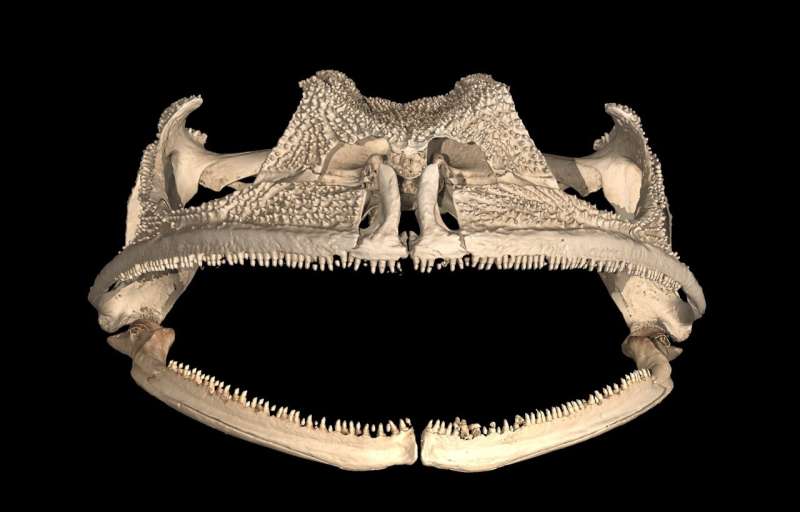Species feared extinct is the only frog with true teeth on its lower jaw

In a new study published in Evolution, biologists laid to rest a century-old debate by confirming that a single species of frog, out of the more than 7,000 living today, has true teeth on its lower jaw. The culprit, a large marsupial frog named Gastrotheca guentheri, has puzzled scientists since its discovery in 1882 for possessing what appeared to be a complete set of jagged, daggerlike teeth on the top and bottom of its mouth.
Scientists have since waffled over the exact nature of these structures. True teeth are composed of specific tissues, including dentin and enamel, which are notoriously difficult to observe in frog teeth due to their diminutive size.
"They're incredibly small, each about the size of a grain of sand," said lead author Daniel Paluh, a doctoral candidate in the University of Florida's department of biology. "There's no way to confirm the presence of dentin and enamel in frog teeth without using high-resolution techniques."
Frogs have lacked teeth on their lower jaw since their first appearance in the fossil record more than 200 million years ago. A single living species with a full dentition thus seemed unlikely at best and contradicted a long-standing biological theory, called Dollo's Law, which states that once a complex trait is lost in an organism, it never returns.
But frogs are known for flouting the rules when it comes to teeth. Although their basic body shape and anatomy have remained largely unchanged since the Jurassic period, Paluh and his colleagues recently determined that frogs have lost their teeth on more than 20 separate occasions and may have regained them an additional six times throughout their evolutionary history.
Some species, such as those that feed on ants and termites, are entirely toothless, relying instead on their sticky, projectile tongues to reel in food. Frogs that go after larger morsels are often equipped with a row of teeth on their upper jaw and a toothy, serrated palate on the top of their mouths, which helps keep wiggling prey from escaping.
In rare cases, some species have evolved large bony fangs that protrude from their lower jaw and superficially resemble teeth but lack the tell-tale dentin and enamel tissues. And instead of the conveyor-belt system of tooth replacement in other frogs, fangs grow only once and cannot be replaced.
For decades, no one was sure whether the structures on G. guentheri's lower jaw were bones masquerading as teeth or the genuine article. Finding a specimen to settle the question wasn't easy, either. Native to the cloud forests of Colombia and Ecuador, the last recorded observation of G. guentheri was made in 1996, prompting fears the species may have since succumbed to extinction.
A handful of G. guentheri are preserved as museum specimens, but given their rarity, biologists are hesitant to subject them to the type of destructive analyses that would be required to study their teeth. But Paluh was able to capitalize on a peculiar feature of Gastrotheca's biology to use a preserved embryo as a sample rather than a full-sized adult.
Rather than laying eggs in ponds or streams, female marsupial frogs carry them around in a pouch on their back. "In the case of G. guentheri, these eggs will skip the tadpole stage and hatch directly into miniature versions of the adult called froglets," Paluh said.
The researchers took CT scans of the embryo's jaws and carefully stained razor-thin sections of individual teeth with dyes that bind to enamel and dentin, with unequivocal results. G. guentheri's teeth were virtually identical to those of other frog species in their overall shape, development and the tissues they were composed of.
"This was surprising given the extreme length of time since they were lost and regained," Paluh said. "Our expectation was that if they did regain teeth, they would somehow be different, but that's not what we saw at all."
As to how structures that have remained absent for millions of years reappeared in an otherwise unassuming frog, Paluh suspects the answer resides in the complex pathway of dental development retained in the majority of living amphibians. Although the location of teeth can vary from species to species, the same basic genetics likely underlies their development, and producing them on the lower jaw might be as simple as throwing a switch.
Paluh plans on leveraging several genetic tools in the near future to map the contours of tooth development and evolution in frogs, but for G. guentheri and a host of other imperiled species in the American tropics, finding the exact answer may no longer be possible. DNA degrades over time in plants and animals stored in museum collections, and the scant number of aging G. guentheri specimens aren't likely viable resources for genetic study.
"We've seen many species in this group become endangered due to climate change, habitat degradation and chytrid fungus disease," Paluh said. "We won't be able to answer these questions in any other group because these traits don't exist anywhere else in the frog tree of life."Taking a bite out of tooth evolution: Frogs have lost teeth more than 20 times
More information: Daniel J. Paluh et al, Re‐evaluating the morphological evidence for the re‐evolution of lost mandibular teeth in frogs, Evolution (2021). DOI: 10.1111/evo.14379
Journal information: Evolution
Provided by Florida Museum of Natural History
No comments:
Post a Comment